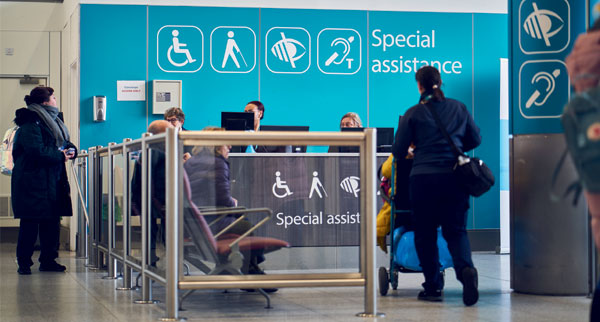Confused about how to access special assistance through an airport? David Whitley has the answers.
Click here to download and save as a PDF.
It would be an unusual traveller who actively enjoys the experience of getting through an airport, but for some, it’s particularly daunting. For most, ‘special assistance’ is something for people in wheelchairs that chugs along quietly in the background. Very little attention is paid to it until personal circumstances change – a hip operation, worsening arthritis, a sprained ankle or a recent move to using a wheelchair – and the airport experience becomes otherwise unmanageable.
Using special assistance for the first time can be highly confusing, partly because resources explaining how it works are thin on the ground, partly because the system varies by airport and by airline, and partly because not all passengers have the same needs.
One commonality, however, is that it should be arranged in advance. Michelle Foster, head of special assistance at Manchester airport, says: “It is really important that any passenger requiring special assistance contacts their airline to notify them of their specific requirements as early as possible. Once this is done, the special-assistance service provider – ABM here at Manchester – receives notification from that airline 36 hours prior to the passenger’s journey.
“They can then ensure that they have the correct resource levels and equipment to provide a seamless experience on the day. Notification rates in Manchester are around 70%, which means that 30% of passengers just arrive at the airport expecting someone to be available to assist them. This can sometimes cause delays, particularly if specialist equipment is required.”

How to access assistance
At all British and most major overseas airports, assistance can start from arrival. Help points at the car parks, terminal entrances and train stations can be used to alert the special-assistance team, who’ll meet passengers.
From there, if needed, passengers will be escorted through check-in and security, then picked up again from a special waiting area (or pre-agreed meeting point such as a lounge) to go through the boarding process.
It is important that any passenger requiring special assistance contacts their airline as early as possible.
At the other end, it works in reverse – passengers are met at their seat or at the aircraft door, depending on requirements, then escorted through immigration, customs and baggage reclaim to the taxi rank, car park or train station.
As for the getting around part, sometimes it’s a case of being driven in a motorised buggy; at others, being pushed in a wheelchair.
Fast fact
Nearly half a million British Airways passengers need assistance each year, a number expected to grow by 8% next year.
For passengers with their own wheelchair, there is a lack of consistency. Occasionally there will be space for a manual wheelchair in the cabin; more often, passengers will need to transfer to an aisle-accessible wheelchair during the flight, then pick up their own outside the aircraft door; and sometimes it will need to be checked in at the check‑in desk then picked up at baggage reclaim. Motorised wheelchairs almost always need to be checked in, with any batteries signed off as safe before boarding.
Despite concessions such as special-assistance lanes through security – designed to speed up the process while allowing those who need extra time to have it without feeling under pressure – there is plenty of room for error.
“Motorised wheelchairs almost always need to be checked in, with any batteries signed off as safe before boarding.”
This is particularly the case when travel agent, tour operator, passenger, airline and airport are all involved in the process. Taking responsibility, rather than assuming someone else will, and asking the right questions at the outset should help ensure everything runs smoothly.
Tom Bartlett, commercial operations manager at Gatwick, advises passengers requiring special assistance to allow a little extra time so they don’t feel stressed on arrival.
“They should also clearly describe their requirements when booking their ticket or assistance,” he adds. “For example, can they do stairs? Or walk long distances? Do they have a hidden disability? Do they feel anxious in busy places? Any detail will really help our service provider deliver an excellent service and have the correct equipment in advance.”

Code breaking
For agents, a lot of this can be done via SSR (special service request) codes that can be added at the time of booking or, if need be, afterwards.
There are several relevant codes for those who will require wheelchair assistance at the airport. WHCR is for passengers who need assistance, but can walk a short distance and manage stairs. WHCS is for those who can’t manage stairs, WHCH for those who need help all the way to the aircraft seat and WCMP for passengers with a manual wheelchair.
There are also codes for specific conditions, such as BLND for blind and partially sighted and DEAF for deaf and hard of hearing. Lesser-known is DPNA, for passengers with developmental or intellectual difficulties – autism, for example – who might require a bit of extra guidance or quiet seating arrangements in the airport. Travelport has been striving to raise awareness among agents of this code, which needs to be accompanied by additional descriptive free text, so the level of support required is understood.
“Abta has a downloadable checklist covering aspects such as wheelchair dimensions, medication that needs to be taken on board and assistance dogs.”
Individual airports are also developing schemes to help passengers with invisible disabilities. The assistance desk at Manchester airport, for example, offers special sunflower-patterned lanyards. Staff are trained to look out for these lanyards, whose wearers might need a bit more help and understanding. Heathrow operates a similar sunflower lanyard scheme, which is detailed on its website.
For agents, understanding the SSR codes helps with asking clients the right questions. But if more detail is required, Abta has a downloadable checklist, covering aspects such as wheelchair dimensions, medication that needs to be taken on board and assistance dogs.
Peace of mind is important too. Checking with the airline 48 hours before departure that the required information is on the booking, or advising the customer to do so, can calm jitters. Getting that bit of extra help might seem a little complicated, but it doesn’t take much to remove stress from the customer’s travel experience.
Read more
Flying lessons: The best training courses
Accessible tourism: Tips to aid booking
Myth-busting: Accessible tourism




